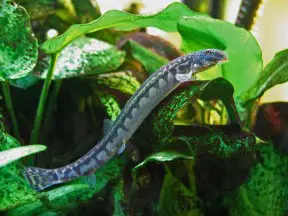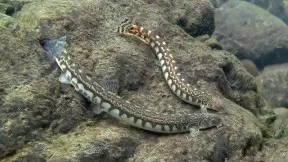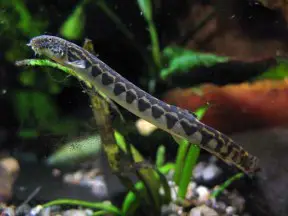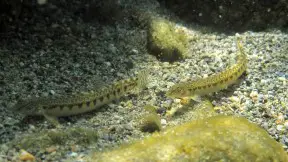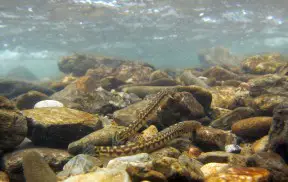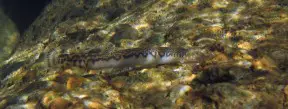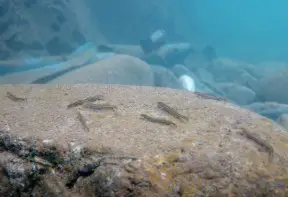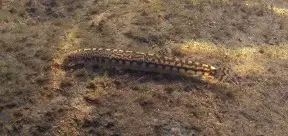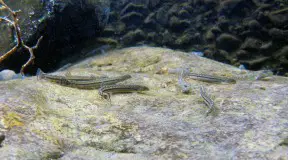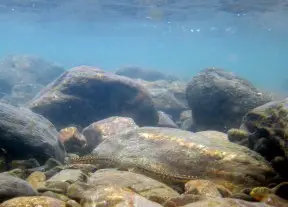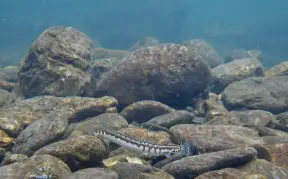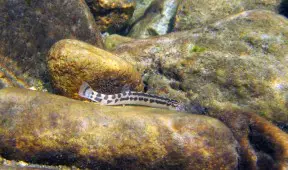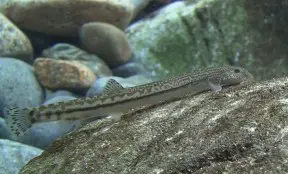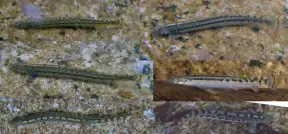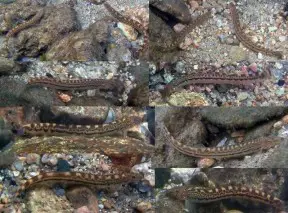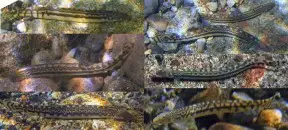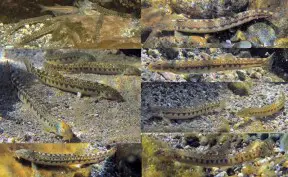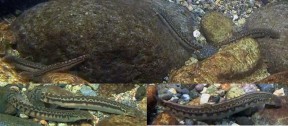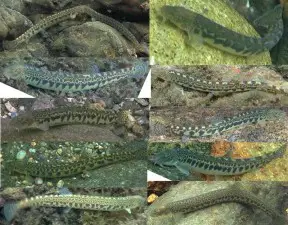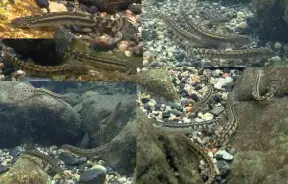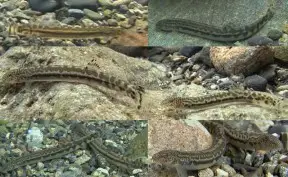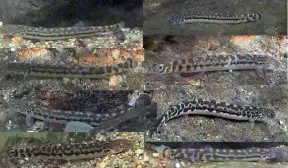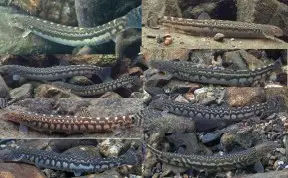Niwaëlla delicata
Ajime Loach
SynonymsTop ↑
Cobitis delicata Niwa, 1937
Etymology
delicata: from the Latin delicatus, meaning ‘delicate, frail’.
Classification
Order: Cypriniformes Family: Cobitidae
Distribution
Appears restricted to river drainages of central Honshu, Japan’s largest island, where it’s a prized food fish with the vernacular name ‘Ajime dojo’ translating as ‘tasty loach’.
Type locality is ‘Agi River, branch stream of Kiso River, central Japan’.
Habitat
Restricted to shallow, fast-flowing, highly-oxygenated headwaters and minor tributaries characterised by stretches of riffles and runs broken up by pools or cascades in some cases.
Substrates are normally composed of smaller rocks, sand and gravel with jumbles of boulders, and while riparian vegetation and patches of submerged leaf litter are common features aquatic plants aren’t usually present.
The most favourable habitats contain clear, oxygen-saturated water which, allied with the sun, facilitates the development of a rich biofilm carpeting submerged surfaces.
During winter months N. delicata retreats to streams or underflows where it remains dormant between October and April (Kano, 2000) before emerging to spawn. Other species living alongside it in nature include Rhinogobius flumineus, Cottus pollux and Phoxinus spp.
Maximum Standard Length
90 – 110 mm.
Aquarium SizeTop ↑
An aquarium base measuring 90 ∗ 30 cm should be the smallest considered.
Maintenance
Most importantly the water must be clean and well-oxygenated so we suggest the use of an over-sized filter as a minimum requirement.
Turnover should ideally be 10-15 times per hour so additional powerheads, airstones, etc. should also be employed as necessary.
Base substrate can either be of gravel, sand or a mixture of both to which should be added a layer of water-worn rocks and pebbles of varying sizes.
Aged driftwood can also be used but avoid new pieces since these usually leach tannins that discolour the water and reduce the effectiveness of artificial lighting, an unwanted side-effect since the latter should be strong to promote the growth of algae and associated microorganisms.
Exposed filter sponges will also be grazed, and some enthusiasts maintain an open filter in the tank specifically to provide an additional food source.
Although rarely a feature of the natural habitat aquatic plants can be used with adaptable genera such as Microsorum, Crinum and Anubias spp. likely to fare best. The latter are particularly useful as their leaves tend to attract algal growth and provide additional cover.
Since it needs stable water conditions and feeds on biofilm this species should never be added to a biologically immature set-up, and a tightly-fitting cover is necessary since it can literally climb glass.
While regular partial water changes are essential aufwuchs can be allowed to grow on all surfaces except perhaps the viewing pane.
Water Conditions
Temperature: For general care 20 – 24 °C is recommended but it should withstand warmer conditions provided dissolved oxygen levels are maintained.
pH: 6.5 – 7.5
Hardness: 0 – 143 ppm
Diet
Much of the natural diet is likely to be composed of benthic algae plus associated micro-organisms which are rasped from solid surfaces.
In captivity it will accept good-quality dried foods and meatier items like live or frozen bloodworm but may suffer internal problems if the diet contains excessive protein.
Home-made foods using a mixture of natural ingredients bound with gelatin are very useful since they can be tailored to contain a high proportion of fresh vegetables, Spirulina and similar ingredients.
For long-term success it’s best to provide a mature aquarium with a plentiful supply of algae-covered rocks and other surfaces.
If unable to grow sufficient algae in the main tank or you have a community containing numerous herbivorous fishes which consume what’s available quickly it may be necessary to maintain a separate tank in which to grow algae on rocks and switch them with those in the main tank on a cyclical basis.
Such a ‘nursery‘ doesn’t have to be very large, requires only strong lighting and in sunny climates can be kept outdoors. Algal type is also important with diatoms and softer, green varieties preferred to tougher types such as rhodophytic ‘black brush’ algae.
Balitorids are often seen on sale in an emaciated state which can be difficult to correct. A good dealer will have done something about this prior to sale but if you decide to take a chance with severely weakened specimens they’ll initially require a constant source of suitable foods in the absence of competitors if they’re to recover.
Behaviour and CompatibilityTop ↑
Likely to be peaceful although its environmental requirements limit the choice of suitable tankmates somewhat, so research your choices before purchase in order to be sure.
Species inhabiting similar environments include Barilius, Discherodontus, Garra, larger Devario, some Rasbora, Rhinogobius, Sicyopterus and Stiphodon gobies plus catfishes like Glyptothorax, Akysis and Oreoglanis.
Many loaches from the family Nemacheilidae, Balitoridae and Gastromyzontidae should also prove suitable although harmless squabbles may occur with the latter group in particular.
Like many loaches it’s loosely territorial towards conspecifics but seems to require their presence to truly thrive. A group of four or more specimens should be the smallest considered.
Sexual Dimorphism
Unlike in the majority of cobitid loaches males of Niwaella spp. lack a lamina circularis on the pectoral fins, meaning young specimens can be difficult to sex accurately.
Older females grow considerably (15 – 20 mm) larger than males and apparently develop a deeper body shape.
Reproduction
Unrecorded.
NotesTop ↑
It’s unlikely this species has yet made its way into the international aquarium hobby though it is available in Japan.
It’s most easily told apart from congeners by colour pattern, consisting of a dark longitudinal stripe or series of blotches running along the lateral line, often with additional blotches below, whereas other members of the genus exhibit some degree of vertical barring and/or a dark stripe extending posteriorly from the pectoral-fin.
Niwaëlla is closely related to Cobitis and N. delicata, also the type species, was originally described as C. delicata (Niwa, 1937).
The combination of characters used to tell it apart include: relatively small head; presence (vs. absence) of a sucker-like mouth; relatively short barbels; relatively thick, curved sub-ocular spine; presence (vs. absence) of adipose crests along the dorsal surface of the caudal peduncle; dorsal-fin in rear half of body; absence (vs. presence) of lamina circularis in males; 6 branched dorsal-fin rays.
Members of the Korean genus Kichulchoia were formerly considered members of Niwaëlla but the similarities in morphology are currently considered more likely to have arisen via parallel evolution rather than biological relatedness (Šlechtová et al. 2008).
The family Cobitidae, often referred to as ‘true’ loaches, is widely-distributed across most of Eurasia with the Indian subcontinent, Southeast Asia and China representing particular centres of species diversity.
Phylogenetic analyses by Tang et al. (2006), Šlechtová et al. (2007) and Šlechtová et al. (2008) revealed that the group constitutes a separate genetic lineage to the family Botiidae (the two were previously grouped together under Cobitidae as subfamilies Cobitinae and Botiinae).
In the most recent study Niwaëlla was found to represent a polyphyletic grouping comprising up to three separate genetic lineages, with the authors suggesting that the similar appearance seen in current members of the genus may be down to convergent evolution rather than genetic relatedness.
They stopped short of renaming the genus but provisionally included it in one of four generalised lineages within a ‘northern’ clade of the family Cobitidae comprising species distributed in Europe, western, northern and eastern Asia, Vietnam and Laos. These are as follows:
1) All Sabanjewia spp.
2) Microcobitis misgurnoides.
3) All Misgurnus, Paramisgurnus and Koreocobitis spp.
4) All Cobitis spp. plus Iksookimia, Niwaëlla and Kichulchoia spp.
All cobitids possess sharp, motile, sub-ocular (below the eye) spines which are normally concealed within a pouch of skin but erected when an individual is stressed, e.g., if removed from the water. Care is therefore necessary as these can become entangled in aquarium nets and, in larger species, break human skin.
References
- Chen, Y.-F. and Y.-X. Chen, 2005 - Journal of Natural History 39(19): 1641-1651
Revision of the genus Niwaella in China (Pisces, Cobitidae), with description of two new species. - Kano, Y., 2000 - Ichthyological Research 47(2): 183-186
Age and growth of the Ajime-loach, Niwaella delicata, in the Yura River, Kyoto, Japan. - Kim, I.-S. and W.-O. Lee, 1995 - Japanese Journal of Ichthyology 42(3/4): 285-290
Niwaella brevifasciata, a new cobitid fish (Cypriniformes: Cobitidae) with a revised key to the species of Niwaella. - Kimizuka, Y., H. Kobayasi and N. Mizuno, 1982 - Japanese Journal of Ichthyology 29(3): 305-310
Geographic distributions and karyotypes of Cobitis takatsuensis and Niwaella delicata (Cobitididae). - Kottelat, M., 2012 - Raffles Bulletin of Zoology Supplement 26: 1-199
Conspectus cobitidum: an inventory of the loaches of the world (Teleostei: Cypriniformes: Cobitoidei). - Tang, Q., H. Liu, R. Mayden and B. Xiong, 2006 - Molecular Phylogenetics and Evolution 39(2): 347-357
Comparison of evolutionary rates in the mitochondrial DNA cytochrome b gene and control region and their implications for phylogeny of the Cobitoidea (Teleostei: Cypriniformes). - Šlechtová, V., J. Bohlen and A. Perdices, 2008 - Molecular Phylogenetics and Evolution 47(2): 812-831
Molecular phylogeny of the freshwater fish family Cobitidae (Cypriniformes: Teleostei): delimitation of genera, mitochondrial introgression and evolution of sexual dimorphism. - Šlechtová, V., J. Bohlen and H. H. Tan, 2007 - Molecular Phylogenetics and Evolution 44(3): 1358-1365
Families of Cobitoidea (Teleostei; Cypriniformes) as revealed from nuclear genetic data and the position of the mysterious genera Barbucca, Psilorhynchus, Serpenticobitis and Vaillantella.
